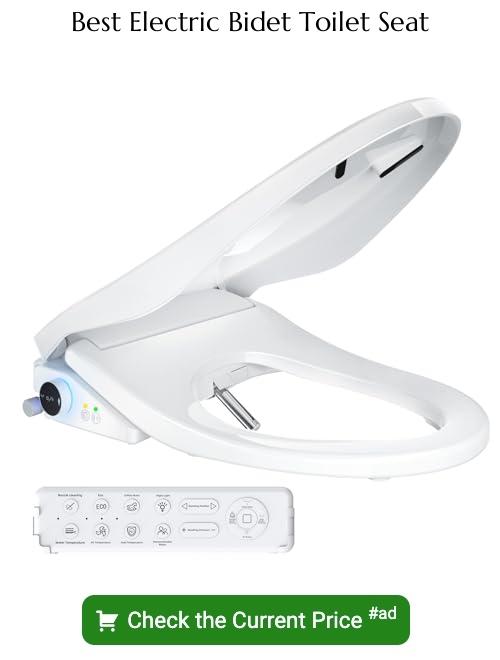Last updated on
Let’s delve into an invigorating comparison of a washlet versus a bidet because understanding their distinct features might just revolutionize your bathroom experience.
Key takeaways:
- Traditional bidets are separate fixtures, while washlets are high-tech toilet seats.
- Washlets require no additional space, making them ideal for smaller bathrooms.
- Installing a bidet may require professional plumbing work, while washlets can usually be DIY-installed.
- Bidets have a higher upfront cost due to potential remodeling, while washlets are more accessible.
- Washlets require electricity and may slightly increase operating costs, while bidets have low operating costs.
What Are They?
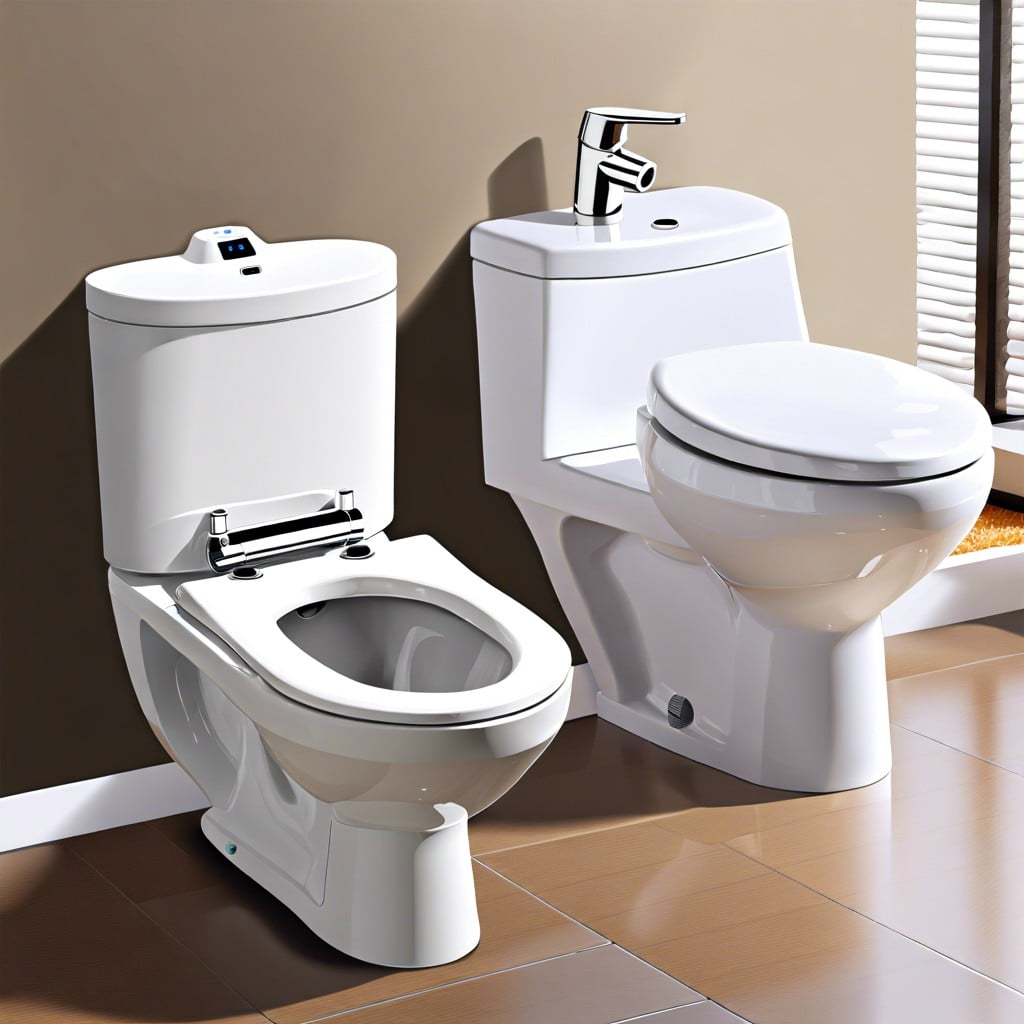
Diving right into the heart of our topic, let’s shed light on the essentials distinguishing a washlet from a bidet:
- Traditional Bidets: Stemming from European origins, these are separate bathroom fixtures similar in size to a toilet, designed for washing after toilet use. They typically feature a faucet and knobs to control the water spray.
Washlets: A contemporary evolution originating from Japan, washlets are essentially high-tech toilet seats. They come with built-in bidet functions such as warm water spray, temperature control, and often an air dryer.
Key difference alert: while a bidet is a standalone piece, washlets upgrade your existing toilet with their incredible functionality. This fundamental distinction drives the further nuances we’ll explore regarding space, installation, and user experience.
Space Requirements
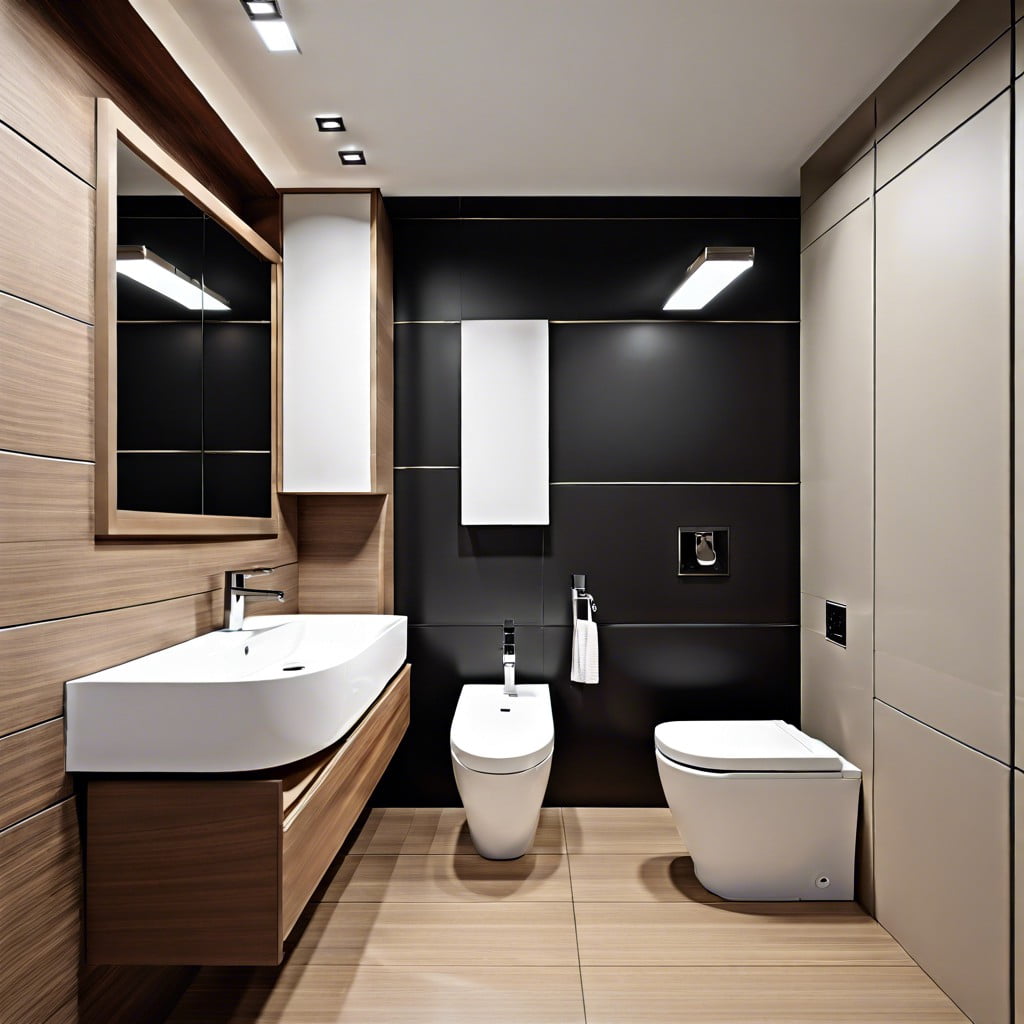
Evaluating your bathroom layout is crucial when choosing between a washlet or a bidet. Traditional bidets require additional floor space, similar to that of a small toilet. Consider if your bathroom can accommodate another fixture alongside the existing toilet.
In contrast, washlets are designed to be integrated with your current toilet seat. This means they take up no additional space, making them a favorable choice for smaller bathrooms or for those who prefer a less cluttered look.
When planning, remember to account for accessibility and comfortable movement within the bathroom. This is key to ensuring a seamless integration of either option into your daily routine.
Installation Process
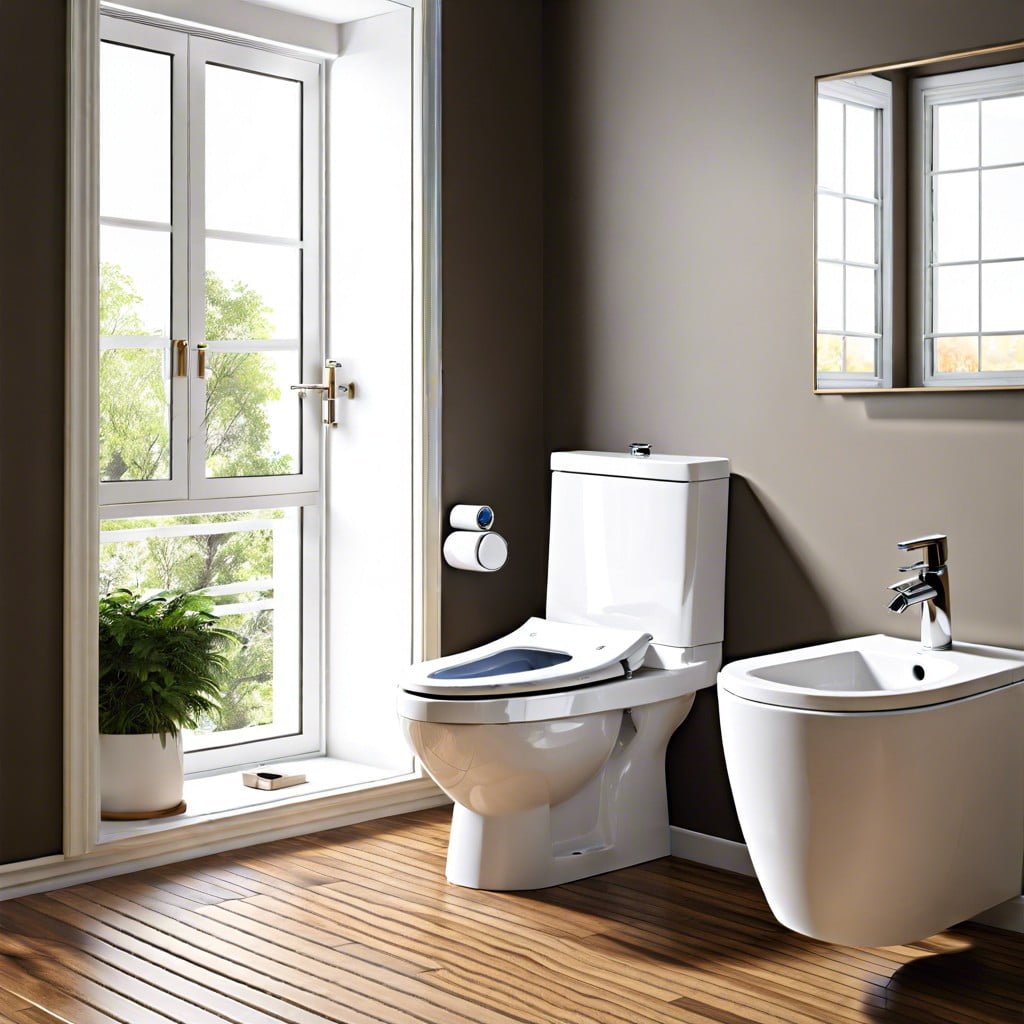
Navigating the installation of washlets and bidets involves a few considerations. For traditional bidets, professional plumbing work is often required to accommodate a new fixture in the bathroom – think of it as installing a small sink. It’s a permanent change to the bathroom layout and might involve significant rearrangement.
On the flip side, washlets – advanced toilet seats with bidet functionality – usually take the DIY route. Most models are designed to be user-friendly; they attach to your existing toilet with basic hand tools. The key here is ensuring a nearby GFCI electrical outlet to power the unit, a detail that sometimes gets overlooked.
Here’s a quick list of what to remember:
- Assess electrical access for washlets.
- Plan for potential plumbing alterations for standalone bidets.
- Read installation guides before purchasing to ensure compatibility with your bathroom.
- Consider the proximity of the bidet or washlet to other bathroom fixtures.
- Check if local building codes or permits are a factor for installation.
Initial Costs
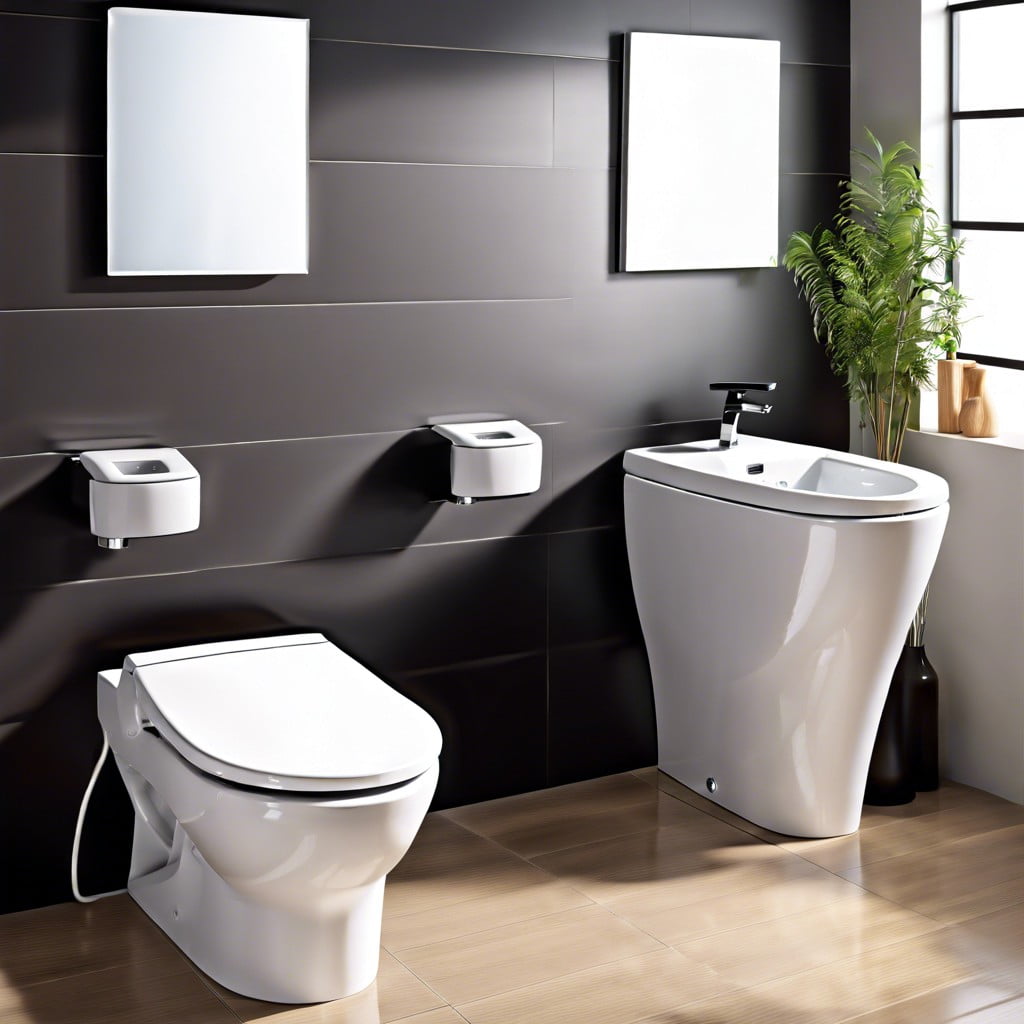
When assessing the financial implications of installing a washlet or a bidet, it’s essential to note that they present different price points. Traditional stand-alone bidets may necessitate substantial bathroom remodeling, potentially involving new plumbing and floor work, which can drive up initial costs significantly.
On the other hand, washlets, or bidet toilet seats, are more accessible in terms of upfront expenses. They are designed to be retrofitted onto your existing toilet, allowing a more straightforward and less costly installation.
However, upscale washlet models equipped with features like warm air dryers, heated seats, and customizable water settings may come with a heftier price tag, aligning them with or surpassing the cost of a traditional bidet setup.
As you budget for your bathroom upgrade, these points should be considered to help inform your decision between these two options.
Operating Costs
Understanding the long-term expenses of your bathroom fixtures is essential. With a traditional bidet, your operating costs are generally low; the main expense is water usage, which may not significantly increase your utility bill.
Electric washlets, however, require power to heat water, operate nozzles, and provide additional functions like drying, which can lead to a slight uptick in your electricity expenses. It’s also worth noting that sophisticated models with air filters, heated seats, and nightlights will draw more power.
While the cost is typically minimal, it is an ongoing consideration compared to a non-electric bidet. Regular maintenance for both options is required, though some high-tech washlet features may lead to more costly repairs if issues arise.
Ease of Use
Navigating the functions of a washlet is often as straightforward as reaching for a remote control or a side panel, with clearly marked buttons for water pressure, temperature, and nozzle position. Many come equipped with user-friendly features, such as seat warming and deodorizers, enhancing the overall experience with just the touch of a button.
In contrast, traditional bidets might have a steeper learning curve for some, usually requiring manual adjustment of taps to regulate water temperature and pressure. While the process is typically quick to master, it doesn’t offer the same level of immediate convenience and precision as its high-tech counterpart. Adjusting to the use of a bidet for the first time might involve some trial and error to find the most comfortable settings and angles.
Ultimately, the ease of use for both options will largely depend on personal comfort with technology and adaptability to new bathroom routines.
Comfort and Features
Diving into the world of personal hygiene, both washlets and bidets offer unique comfort features that elevate the bathroom experience.
When it comes to a washlet, you can look forward to the luxury of a heated seat, adjustable water temperature, and pressure controls right at your fingertips. Many models also boast deodorizing filters and the convenience of a warm air dryer, removing the need for toilet paper.
Bidets, while more traditional, are not without their own comfort perks. Many offer a refreshing stream of water that can be manually adjusted to suit your preference. Some high-end bidets also come with features like warm water options, but these are less common and often require external hot water sources.
The choice between the two may come down to the level of customization you desire. Do you prioritize the self-cleaning nozzles and user presets that a washlet can offer, or is the simplicity and directness of a bidet more your style? Each caters to different comforts and the decision ultimately aligns with personal preference.
Hygiene and Health Benefits
Embracing a washlet or bidet elevates personal cleanliness with a gentle, cleansing stream of water, a refreshing alternative to traditional toilet paper. Both options are known for reducing the potential for bacteria to spread, thus potentially lowering the risk of infections and promoting better skin health.
Especially for those with limited mobility, hemorrhoids, or after childbirth, the soothing water can be far less irritating than paper. Furthermore, for individuals who suffer from conditions such as anal fissures or irritable bowel syndrome, a water cleanse can provide a more hygienic and less abrasive method of personal care.
Additionally, some washlet models offer features like adjustable water temperature and pressure, ensuring a customized clean that can contribute to improved hygiene and overall health.
Water Usage and Efficiency
Regarding water conservation, bidets and washlets differ significantly from traditional toilet paper usage. Traditional bidets typically use more water per use compared to washlets. However, both are more efficient than using toilet paper, which involves the water-intensive process of manufacturing and disposal.
Washlets are equipped with adjustable water jets, ensuring efficient use of water with each use—allowing for a tailored, efficient clean. Moreover, many modern washlets come with eco-friendly settings, which further reduce water consumption without compromising hygiene.
An important aspect to consider is the reduction in the need for toilet paper, which not only saves trees but also reduces the water used in paper production. By switching to a bidet or washlet, households can therefore have a lower water footprint in the bathroom.
Regular maintenance ensures optimal water efficiency over time, preventing leaks or drips that could lead to water wastage. Both options provide an efficient alternative to the traditional use of toilet paper, aligning well with eco-conscious lifestyle choices.
Maintenance and Cleaning
Maintaining both washlets and bidets is generally straightforward, but there are some differences to be aware of. For washlets, you’ll regularly need to clean the nozzle, which is typically self-cleaning, but also benefits from manual cleaning with a mild cleaner. It’s important to avoid harsh chemicals that could damage the electronic components. The deodorizing filter in a washlet also needs occasional replacement.
With traditional bidets, the absence of electronic components means you can use a wider range of cleaning products. The bowl requires cleaning just like a regular toilet, and it’s essential to scrub under the rim where the water jets are located to prevent buildup.
It’s good practice to wipe down both types of fixtures after use to keep them sanitary. For intricate parts, a soft-bristled brush can clean hard-to-reach areas without causing scratches. Always refer to the manufacturer’s manual for specific care instructions to ensure longevity and optimal performance.
Environmental Impact
Switching from traditional toilet paper to a washlet or bidet can significantly reduce your environmental footprint. Consider these points:
- Paper Reduction: Bidets and washlets drastically cut down the need for toilet paper, saving trees and reducing the energy used in paper production.
- Water Conservation: Modern bidets and washlets often use a minimal amount of water and are designed to be eco-efficient.
- Sewage Treatment: Less toilet paper means fewer clogs and easier processing at sewage treatment facilities.
- Chemical Use: With less demand for toilet paper, there’s a reduction in the chemicals used for paper manufacturing, which benefits the environment.
By understanding these impacts, you can make an informed decision that aligns with your ecological values.
Resale Value Impact
Upgrading your bathroom with modern fixtures often increases your home’s appeal to potential buyers. When it comes to choosing between a washlet and a bidet, consider the market trends in your area.
Washlets, with their high-tech features, tend to attract tech-savvy buyers or those looking for a spa-like bathroom experience. On the other hand, a classic bidet can enhance the bathroom’s elegance and appeal to those who prefer traditional fixtures.
It’s also worth noting that while both options could boost your home’s resale value, the degree of impact varies. The washlet may offer a stronger selling point in regions where bidets are less common, as it provides an all-in-one solution that minimizes space use and is perceived as a luxury addition.
Keep in mind that personal preference plays a role; some buyers may not value these bathroom upgrades as much as others. However, as awareness of water conservation and hygiene increases, the added value of having a washlet or bidet installed could become a more universally attractive feature in the housing market.
Durability
Investing in bathroom fixtures is a long-term commitment; hence, considering the longevity of washlets and bidets is pivotal.
Traditional bidets, often made from ceramic, have a reputation for enduring years of use with minimal wear and tear. They’re sturdy, with fewer mechanical parts that could break down over time.
In contrast, washlets feature more complex technology, which might require more frequent maintenance or replacement of parts such as control panels or nozzles. However, high-quality washlets are designed to last, with many manufacturers providing extensive warranties and customer support to ensure their longevity.
Proper care, including regular cleaning and adherence to usage guidelines, can significantly extend the life of both washlets and bidets.
Popular Models and Brands
When considering a washlet or bidet, the brand can greatly influence the quality, features, and longevity of the product. TOTO is a leader in the washlet market, known for its innovative features like heated seats, automatic lids, and personal cleansing systems. Their popular S300e and S550e models bring luxury and advanced technology into the restroom.
Alternatively, Bio Bidet stands out with its range of bidets and washlets, offering features such as stainless steel nozzles, warm air dry, and hybrid water heating. The BB-2000 Bliss and BB-1000 Supreme are favorites for their robust performance and comfort.
Brondell is another notable brand with a lineup of bidet attachments, seats, and sprays that cater to a variety of preferences and budgets. The Swash 1400 is a hit among users for its customizable settings and sleek design.
For bidets, the classic standalone models from companies like Kohler and American Standard typically offer a timeless design. Kohler’s Memoirs is renowned for its stately elegance, while American Standard’s Cadet and SpaLet models feature modern functions in a traditional bidet form.
Lastly, luxe bidet attachments like those from Luxe Bidet are gaining traction for their ease of installation and cost-effectiveness. The Luxe Bidet Neo 120 and Neo 320, for instance, provide a no-frills, straightforward path to enhanced hygiene.
Exploring different models and brands will help you determine which features align with your preferences, ensuring an informed decision for your bathroom upgrade.
Accessibility Options
Considering the needs of individuals with mobility challenges, both washlets and bidets can enhance bathroom independence. Washlets often come with remote controls, adjustable settings, and hands-free operation, making them ideal for users with limited dexterity or physical disabilities.
Traditional bidets may require more manual control, but they can also be fitted with handrails and easy-to-reach taps to improve accessibility. Height-adjustable models are available for both systems, ensuring that they can be tailored to the specific needs of the user for ease of transfer from a wheelchair or walker.
Additionally, for those with visual impairments, audible feedback features in washlets can be a game-changer. By evaluating these accessibility features, you can select the most inclusive option for every household member, ensuring comfort and independence.
FAQ
Is Toto WASHLET a bidet?
Yes, Toto WASHLET is a luxury toilet seat that incorporates electronic bidet functionality.
Do you need toilet paper with a WASHLET?
No, you don’t need toilet paper with a WASHLET as the bidet’s built-in warm air dryer can effectively dry you off after use.
Is there a downside to using a bidet?
While extensively beneficial for hygiene and comfort, excessive use of a bidet can lead to conditions such as anal pruritus and anal incontinence.
What is the benefit of WASHLET?
The benefit of WASHLET is that it provides a more hygienic solution by keeping your toilet bowl clean without the need for harsh chemicals, thus contributing to environmental protection.
How do the cleaning features of a WASHLET compare to a traditional bidet?
A WASHLET provides comprehensive cleaning features, including customizable water temperature and pressure, air deodorizer, and a warm air dryer; thus making it more sophisticated and versatile than a traditional non-electric bidet.
Does the installation process differ between a WASHLET and a regular bidet?
Yes, the installation process does differ between a WASHLET and a regular bidet with the former being more complex due to its electrical components.
Can a WASHLET offer more value for money than a bidet in the long run?
Yes, a WASHLET can offer more value for money than a bidet in the long run due to its advanced features like heated seats, deodorizer, and customizable water pressure.
Recap
